Toyota Prius: Child restraint systems
Before installing a child restraint system in the 2024 Toyota Prius, it is essential to observe certain precautions and understand the different types of systems and installation methods as outlined in the vehicle’s manual. Always use a child restraint system when riding with a small child who cannot properly use a seat belt. For the child's safety, install the child restraint system in a rear seat, as it is the safest location in the vehicle. Ensure to follow the specific installation method provided in the operation manual enclosed with the child restraint system, adhering to all instructions and guidelines to ensure a secure and proper fit. This will help maximize the effectiveness of the child restraint system and ensure the safety of the young passengers.
Table of contents
Points to remember.
Child restraint system.
When using a child restraint system.
Child restraint system installation method
- Fixed with a seat belt
- Fixed with a child restraint LATCH anchor
- Using an anchor bracket (for top tether strap)
- Points to remember
- When using a child restraint system
- Child restraint system fixed with a seat belt
- Child restraint system fixed with a child restraint LATCH anchor
- Using an anchor bracket (for top tether strap)
Points to remember
The laws of all 50 states of the U.S.A. as well as Canada now require the use of child restraint systems.
- Prioritize and observe the warnings, as well as the laws and regulations for child restraint systems.
- Use a child restraint system until the child becomes large enough to properly wear the vehicle's seat belt.
- Choose a child restraint system that suits your vehicle and is appropriate to the age and size of the child.
WARNING
When a child is riding
Observe the following precautions.
Failure to do so may result in death or serious injury.
- For effective protection in automobile accidents and sudden stops, a child must be properly restrained, using a seat belt or child restraint system which is correctly installed. For installation details, refer to the operation manual enclosed with the child restraint system. General installation instructions are provided in this manual.
WARNING
- Toyota strongly urges the use of a proper child restraint system that conforms to the weight and size of the child, installed on the rear seat. According to accident statistics, the child is safer when properly restrained in the rear seat than in the front seat.
- Holding a child in your or someone else's arms is not a substitute
for a child restraint system.
In an accident, the child can be crushed against the windshield or between the holder and the interior of the vehicle.
Handling the child restraint system
If the child restraint system is not properly fixed in place, the child or other passengers may be seriously injured or even killed in the event of sudden braking, sudden swerving, or an accident. Proper installation and secure attachment of the child restraint system are crucial to ensuring the safety of all occupants, particularly young children, during any unexpected driving situations. Always double-check the installation to make sure the child restraint system is firmly in place and complies with both the vehicle’s manual and the restraint system's operation manual.
- If the vehicle were to receive a strong impact from an accident, etc., it is possible that the child restraint system has damage that is not readily visible. In such cases, do not reuse the restraint system.
- Make sure you have complied with all installation instructions provided with the child restraint system manufacturer and that the system is properly secured.
- Keep the child restraint system properly secured on the seat even if it is not in use. Do not store the child restraint system unsecured in the passenger compartment.
- If it is necessary to detach the child restraint system, remove it from the vehicle or store it securely in the luggage compartment.
Child restraint system
Types of child restraint system installation methods
Confirm the installation of the child restraint system with the operation manual enclosed with the system. Following the specific instructions provided in the manual ensures that the child restraint system is installed correctly and securely, reducing the risk of injury in the event of an accident or sudden maneuver. Always refer to the manufacturer's guidelines for proper installation and use of the child restraint system to ensure maximum safety for your child.
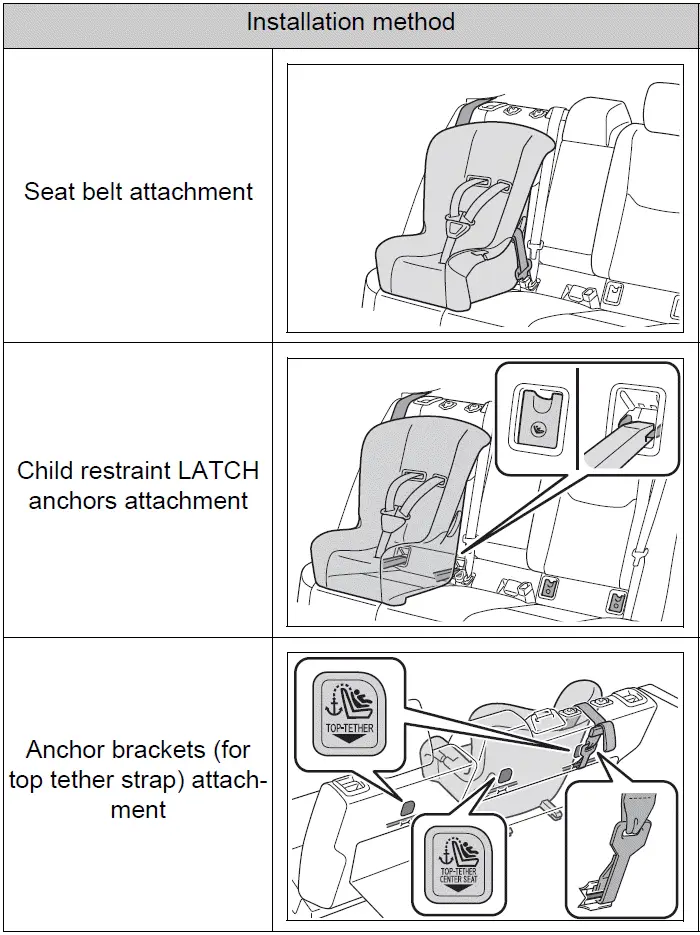
When using a child restraint system
When installing a child restraint system to a front passenger seat
For the utmost safety of a child, it is strongly recommended to install the child restraint system in the rear seats of the vehicle. Rear seats offer better protection and minimize the risk of injury in the event of a collision. However, if installing the child restraint system in a front passenger seat becomes unavoidable due to specific circumstances, it's crucial to take certain precautions and adjust the seat accordingly.
Firstly, adjust the front passenger seat to its rearmost position to provide maximum distance between the child restraint system and the dashboard or airbag deployment area. This helps reduce the risk of injury from airbag deployment in case of an accident. If the vehicle is equipped with an occupant classification system that can deactivate the front passenger airbag, ensure that it is deactivated when using a child restraint system in the front seat.
Next, carefully follow the manufacturer's instructions provided with the child restraint system for proper installation in the front passenger seat. Ensure that the seat is securely anchored and that the child is correctly strapped into the restraint system according to the system's guidelines. Regularly check the stability and positioning of the child restraint system and the child to maintain optimal safety throughout the journey. These adjustments and precautions can help mitigate risks when installing a child restraint system in a front passenger seat as a last resort..
- Adjust the seatback angle to the most upright position.
If there is a gap between the child restraint system and the seatback, adjust the seatback angle until good contact is achieved.
- Move the front seat fully rearward.
- Move the seat to the uppermost position
- If the head restraint interferes with the child restraint system installation
and the head restraint can be removed, remove the head restraint.
Otherwise, put the head restraint in the upper most position.
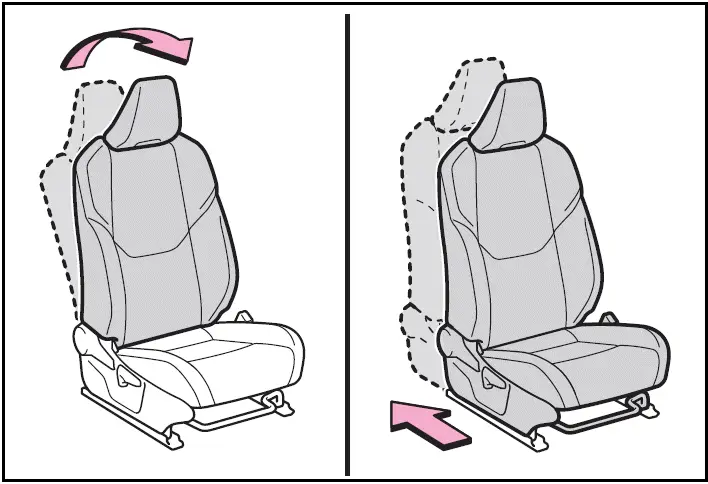
WARNING
When using a child restraint system
Observe the following precautions.
Failure to do so may result in death or serious injury.
- Never install a rear-facing child restraint system on the front passenger
seat even if the "AIR BAG OFF" indicator light is illuminated.
In the event of an accident, the force of the rapid inflation of the front passenger airbag can cause death or serious injury to the child if the rearfacing child restraint system is installed on the front passenger seat.
- A forward-facing child restraint system may be installed on the front passenger seat only when it is unavoidable. A child restraint system that requires a top tether strap should not be used in the front passenger seat since there is no top tether strap anchor for the front passenger seat.
WARNING
- A forward-facing child restraint system may be installed
on the front passenger seat only when it is unavoidable. When installing a forward-facing
child restraint system on the front passenger seat, adjust the seatback angle
to the most upright position, move the seat to the rearmost position, even if
the "AIR BAG OFF" indicator light is illuminated.
If the head restraint interferes with the child restraint system installation and the head restraint can be removed, remove the head restraint.
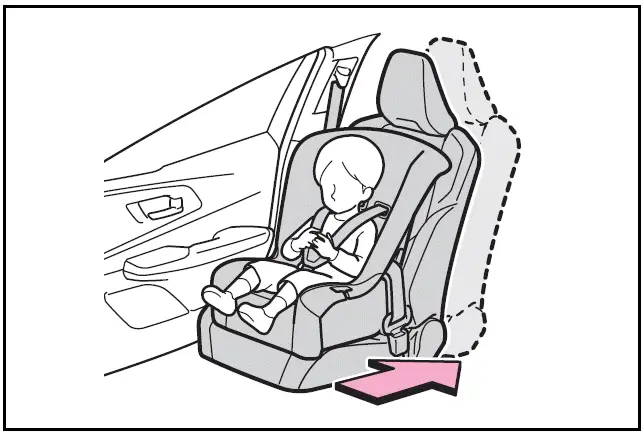
- Do not allow the child to lean his/her head or any part of
his/her body against the door or the area of the seat, front or rear pillars,
or roof side rails from which the SRS side airbags or SRS curtain shield airbags
deploy even if the child is seated in the child restraint system.
It is dangerous if the SRS side and curtain shield airbags inflate, and the impact could cause death or serious injury to the child.
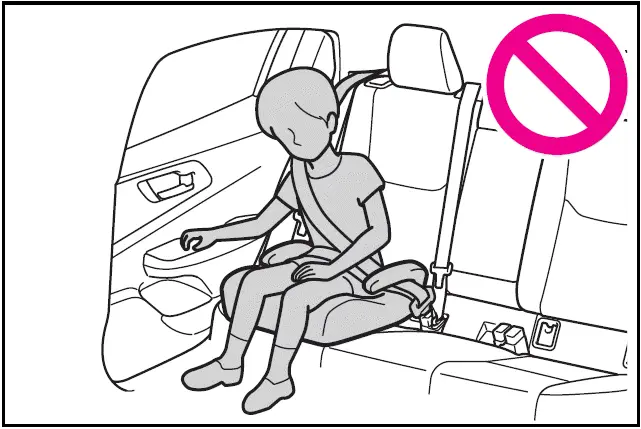
- When a booster seat is installed, always ensure that the shoulder belt is positioned across the center of the child's shoulder. The belt should be kept away from the child's neck, but not so that it could fall off the child's shoulder.
- Use a child restraint system suitable to the age and size of the child and install it to the rear seat.
- If the driver's seat interferes with the child restraint system and prevents it from being attached correctly, attach the child restraint system to the right-hand rear seat.
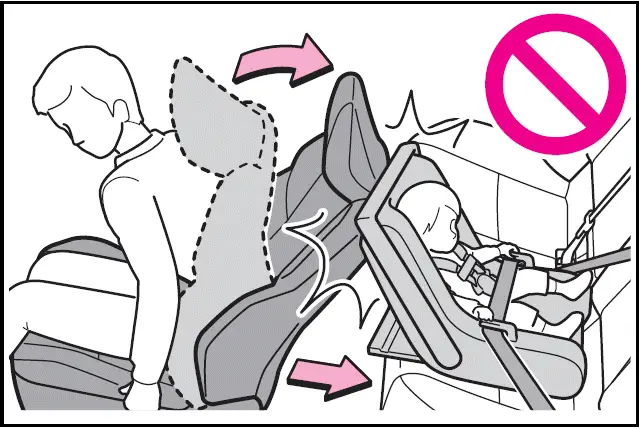
- Adjust the front passenger seat so that it does not interfere with the child restraint system.
Child restraint system fixed with a seat belt
A child restraint system in Toyota Prius for a small child or baby must be properly restrained on the seat using the lap portion of the lap/shoulder belt. This involves securely fastening the child restraint system to the vehicle seat using the designated attachment points or seat belt routing provided by the manufacturer. Ensure that the lap portion of the seat belt is correctly threaded through the designated path on the child restraint system and securely fastened. This helps to properly restrain the child restraint system in place and provides maximum safety for the child in the event of a sudden stop or collision. Always refer to the manufacturer's instructions for the specific child restraint system being used to ensure proper installation and restraint..
Installing child restraint system using a seat belt (child restraint lock function belt)
Install the child restraint system in accordance to the operation manual enclosed with the child restraint system.
Rear-facing - Infant seat/convertible seat
- Adjust the rear seat.
If there is a gap between the child restraint system and the seatback, adjust the seatback angle until good contact is achieved.
- Place the child restraint system on the rear seat facing the rear of the vehicle.
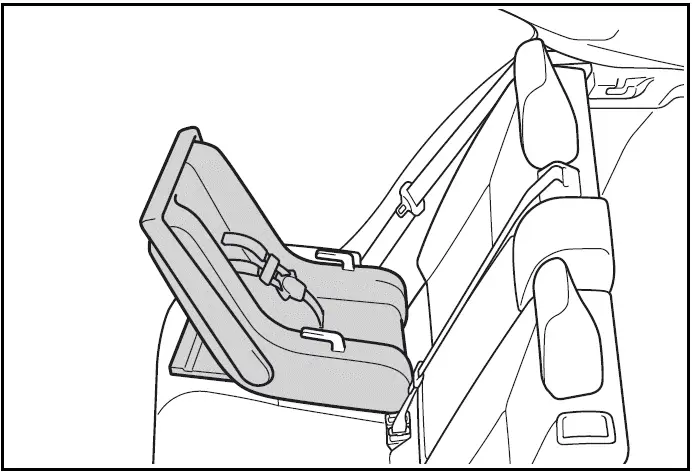
- Run the seat belt through the child restraint system and insert the plate into the buckle. Make sure that the belt is not twisted.
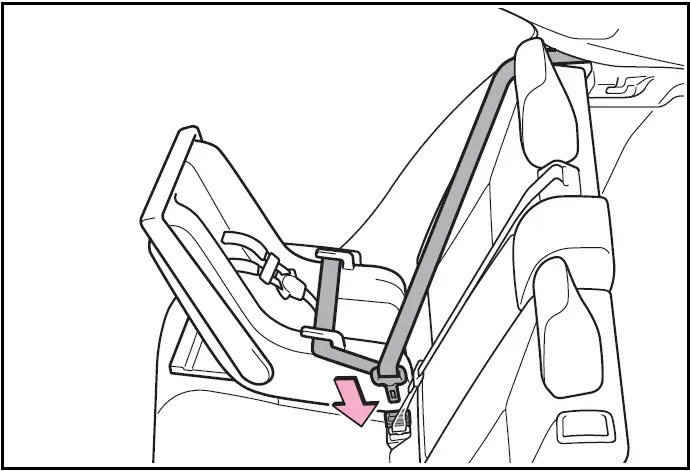
- Fully extend the shoulder belt and allow it to retract to put it in lock mode. In lock mode, the belt cannot be extended.
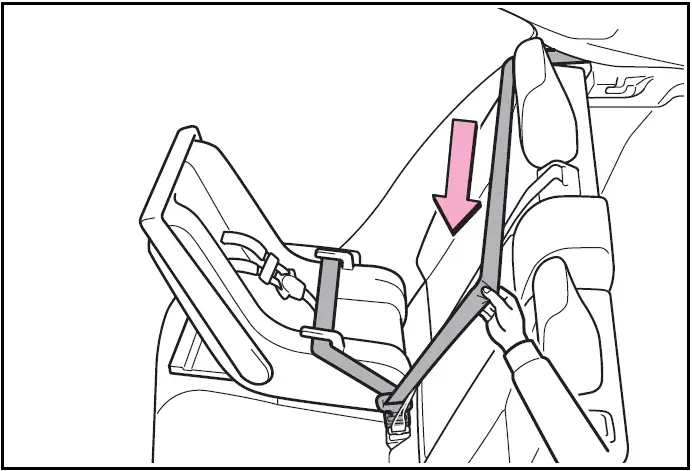
- While pushing the child restraint system down into the rear seat, allow the shoulder belt to retract until the child restraint system is securely in place.
After the shoulder belt has retracted to a point where there is no slack in the belt, pull the belt to check that it cannot be extended
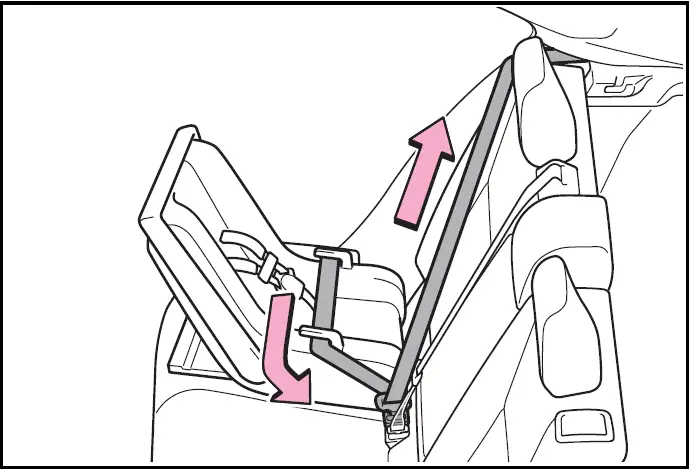
- After installing the child restraint system, rock it back and forth to ensure that it is installed securely.
Forward-facing - Convertible seat
- Adjust the seat.
When using the front passenger seat: If installing the child restraint system to the front passenger seat is unavoidable, refer to for front passenger seat adjustment.
When using the rear seat: If there is a gap between the child restraint system and the seatback, adjust the seatback angle until good contact is achieved.
- If the head restraint interferes with the child restraint system installation and the head restraint can be removed, remove the head restraint.
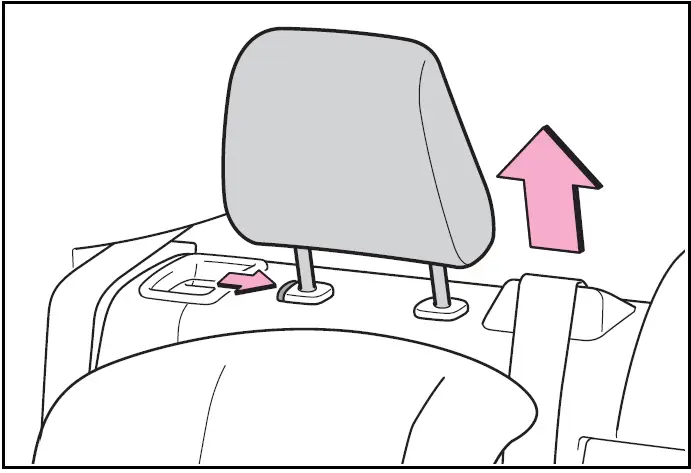
- Place the child restraint system on the seat facing the front of the vehicle.
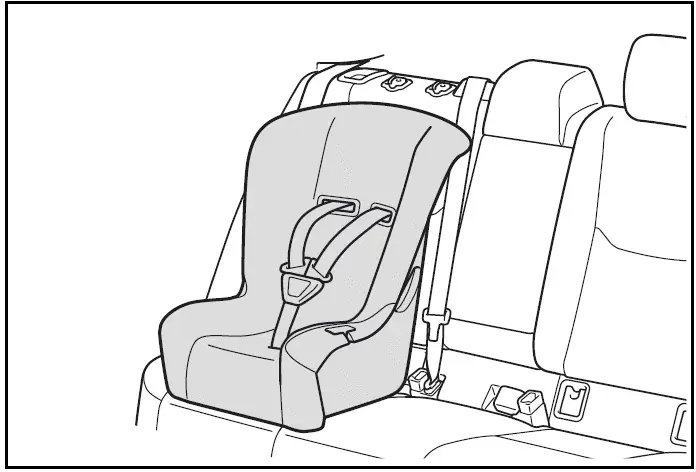
- Run the seat belt through the child restraint system and insert the plate into the buckle. Make sure that the belt is not twisted.
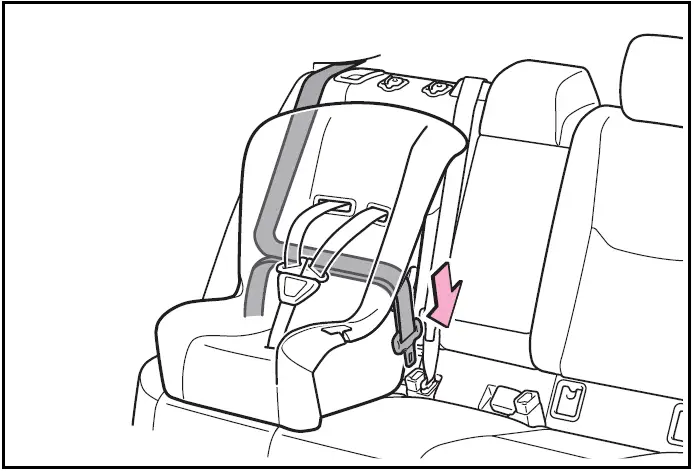
- Fully extend the shoulder belt and allow it to retract to put it in lock mode. In lock mode, the belt cannot be extended.
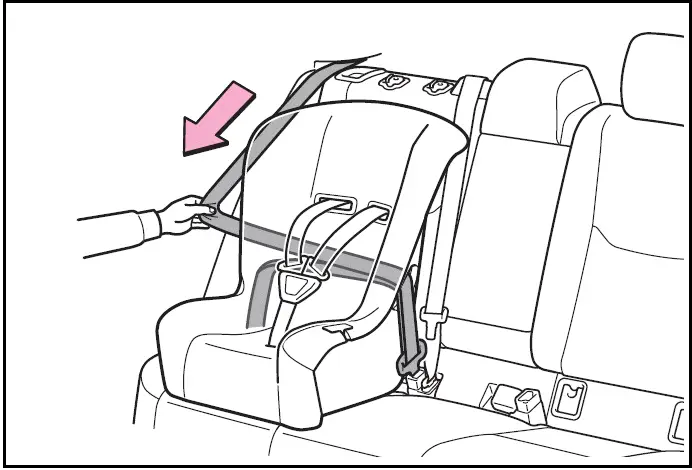
- While pushing the child restraint system into the rear seat, allow the shoulder belt to retract until the child restraint system is securely in place.
After the shoulder belt has retracted to a point where there is no slack in the belt, pull the belt to check that it cannot be extended.
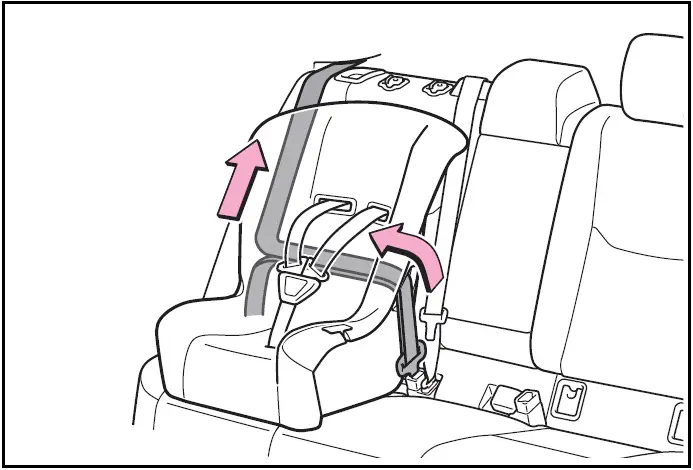
- If the child restraint has a top tether strap, follow the child restraint manufacturer's operation manual regarding the installation, using the top tether strap to latch onto the top tether strap anchor.
- After installing the child restraint system, rock it back and forth to ensure that it is installed securely.
Booster seat
- If installing the child restraint system to the front passenger seat is unavoidable, refer to for front passenger seat adjustment.
- High back type: If the head restraint interferes with your child restraint system, and the head restraint can be removed, remove the head restraint.
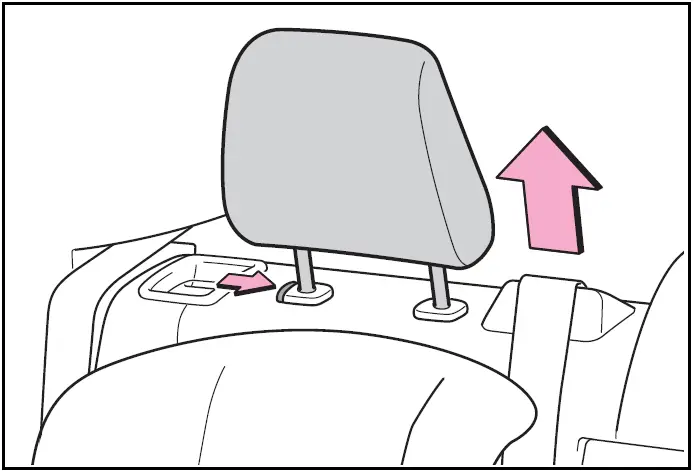
- Place the child restraint system on the seat facing the front of the vehicle.
- Booster type
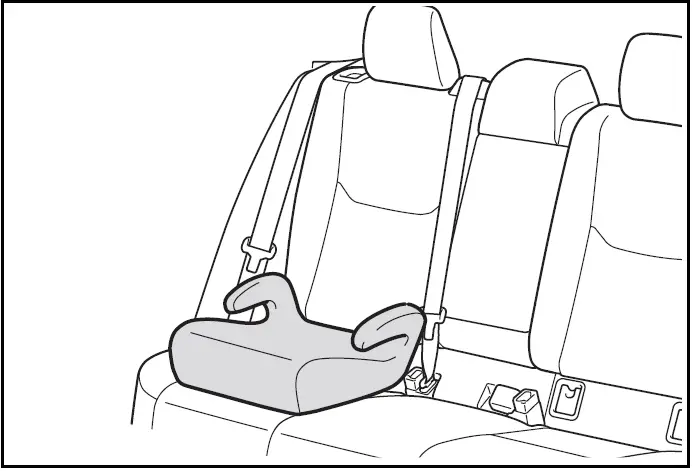
- High back type
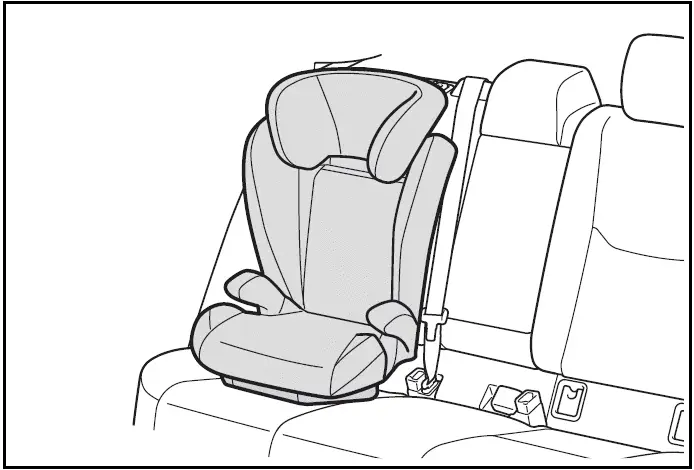
- Sit the child in the child restraint system. Fit the seat belt to the child restraint system according to the manufacturer's instructions and insert the plate into the buckle. Make sure that the belt is not twisted.
Check that the shoulder belt is correctly positioned over the child's shoulder and that the lap belt is as low as possible
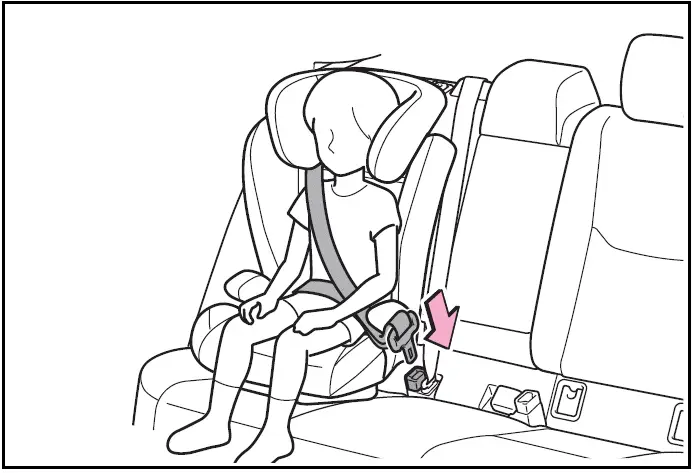
Removing a child restraint system installed with a seat belt
Press the buckle release button and fully retract the seat belt.
When releasing the buckle, the child restraint system may spring up due to the rebound of the seat cushion. Release the buckle while holding down the child restraint system.
Since the seat belt automatically reels itself, slowly return it to the stowing position.
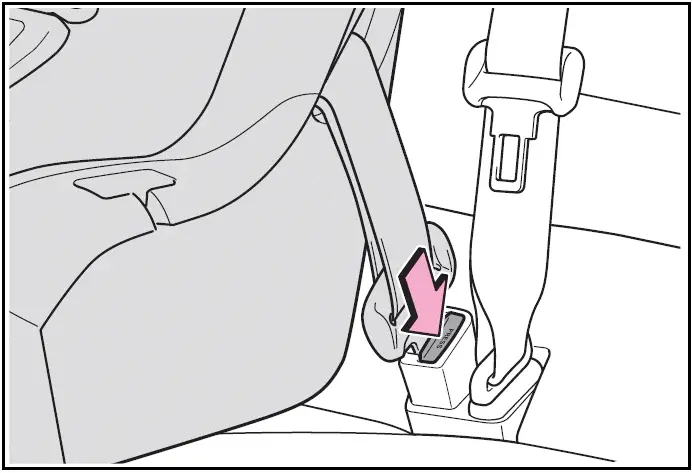
WARNING
When installing a child restraint system
Observe the following precautions.
Failure to do so may result in death or serious injury.
- Do not allow children to play with the seat belt. If the seat belt
becomes twisted around a child's neck, it may lead to choking or other serious
injuries that could result in death.
If this occurs and the buckle cannot be unfastened, scissors should be used to cut the belt.
- Ensure that the belt and plate are securely locked and the seat belt is not twisted.
- Shake the child restraint system left and right, and forward and backward to ensure that it has been securely installed.
- After securing a child restraint system, never adjust the seat.
- When a booster seat is installed, always ensure that the shoulder belt is positioned across the center of the child's shoulder. The belt should be kept away from the child's neck, but not so that it could fall off the child's shoulder.
- Follow all installation instructions provided by the child restraint system manufacturer.
WARNING
- When securing some types of child restraint systems in rear seats,
it may not be possible to properly use the seat belts in positions next to the
child restraint without interfering with it or affecting seat belt effectiveness.
Be sure your seat belt fits snugly across your shoulder and low on your hips. If it does not, or if it interferes with the child restraint, move to a different position. Failure to do so may result in death or serious injury.
When installing a booster seat
To prevent the belt from going into ALR lock mode, do not fully extend the shoulder belt. ALR mode causes the belt to tighten only. This could cause injury or discomfort to the child.
Do not use a seat belt extender
If a seat belt extender is used when installing a child restraint system, the seat belt will not securely hold the child restraint system, which could cause death or serious injury to the child or other passengers in the event of sudden braking, sudden swerving or an accident.
Child restraint system fixed with a child restraint LATCH anchor
Child restraint LATCH anchors
LATCH anchors are provided for the outboard rear seats. (Marks displaying the location of the anchors are attached to the seats.)
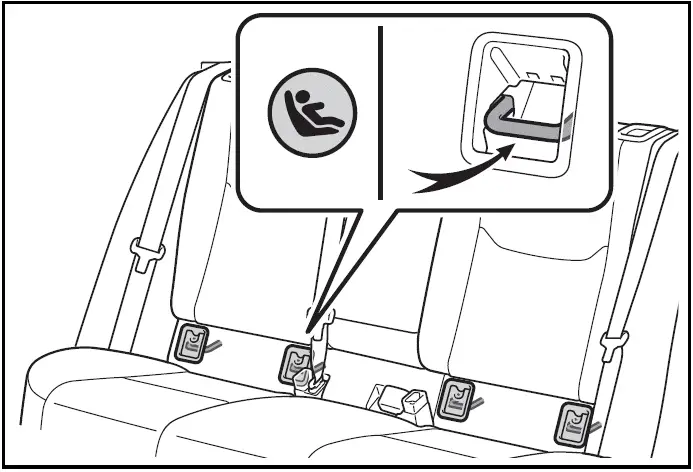
When installing in the rear outboard seats
Install the child restraint system in accordance to the operation manual enclosed with the child restraint system.
- If the head restraint interferes with the child restraint system installation and the head restraint can be removed, remove the head restraint.
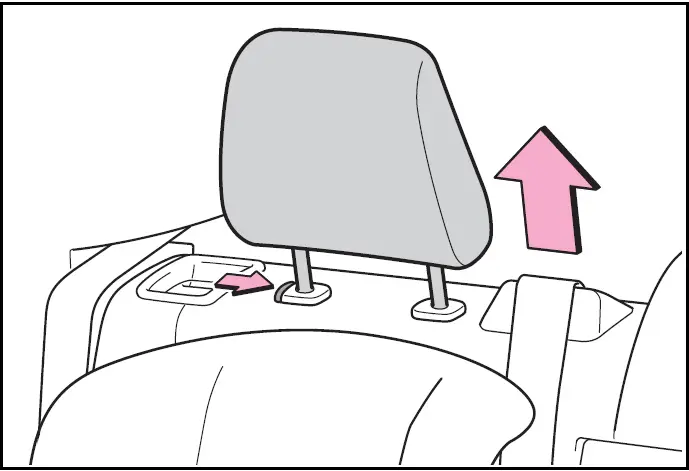
- With flexible lower attachments
- Remove the anchor covers, and latch the hooks of the lower attachments onto
the LATCH anchors.
For owners in Canada: The symbol on a child restraint system indicates
 the presence of a lower
connector system.
the presence of a lower
connector system.
The bars are installed behind the anchor covers.
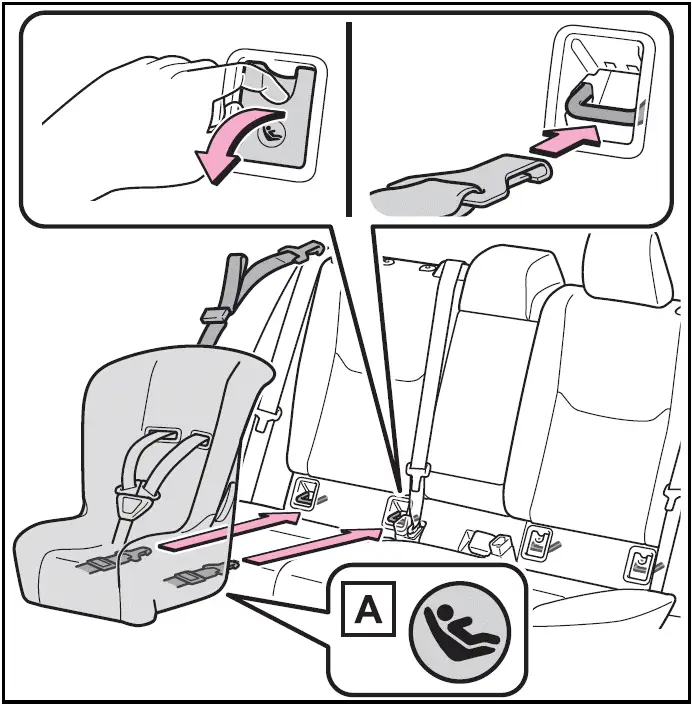
- Canada only
- With rigid lower attachments
- Remove the anchor covers, and latch the buckles onto the LATCH anchors.
For owners in Canada: The symbol on a child restraint system indicates
 the presence of a lower connector
system.
the presence of a lower connector
system.
The bars are installed behind the anchor covers.
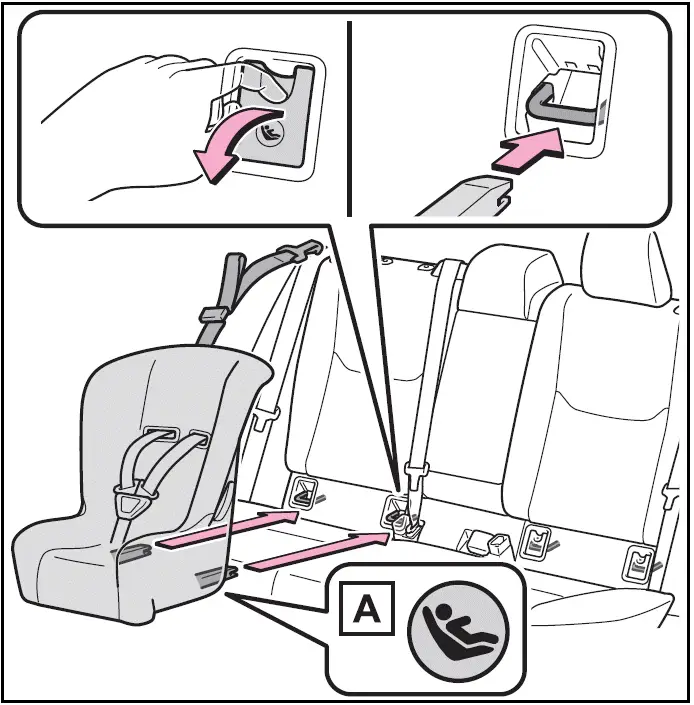
- Canada only
- If the child restraint has a top tether strap, follow the child restraint manufacturer's operation manual regarding the installation, using the top tether strap to latch onto the top tether strap anchor.
- After installing the child restraint system, rock it back and forth to ensure that it is installed securely.
When installing in the rear center seat
There are no LATCH anchors behind the rear center seat.
However, the inboard LATCH anchors of the outboard seats, which are 15.72 in. (399.4 mm) apart, can be used if the child restraint system manufacturer's instructions permit use of those anchors with the anchor spacing stated.
Child restraint systems with rigid lower attachments cannot be installed in the center seat. This type of child restraint system can only be installed in the outboard seat.
Laws and regulations pertaining to anchors
The LATCH system conforms to FMVSS225 or CMVSS210.2.
Child restraint systems conforming to FMVSS213 or CMVSS213 specifications can be used.
This vehicle is designed to conform to SAE J1819.
WARNING
When installing a child restraint system
Observe the following precautions.
Failure to do so may result in death or serious injury.
- When using the LATCH anchors, be sure that there are no foreign objects around the anchors and that the seat belt is not caught behind the child restraint system.
- Follow all installation instructions provided by the child restraint system manufacturer.
- Never attach two child restraint system attachments to the same anchor.
In a collision, one anchor may not be strong enough to hold two child restraint
system attachments and may break.
If the LATCH anchors are already in use, use the seat belt to install a child restraint system in the center seat.
- When securing some types of child restraint systems in rear seats,
it may not be possible to properly use the seat belts in positions next to the
child restraint without interfering with it or affecting seat belt effectiveness.
Be sure your seat belt fits snugly across your shoulder and low on your hips. If it does not, or if it interferes with the child restraint, move to a different position. Failure to do so may result in death or serious injury.
- If the seat is adjusted, reconfirm the security of the child restraint system.
Using an anchor bracket (for top tether strap)
Anchor brackets (for top tether strap)
Anchor brackets are provided for each rear seat.
Use anchor brackets when fixing the top tether strap.
- Outboard rear seats
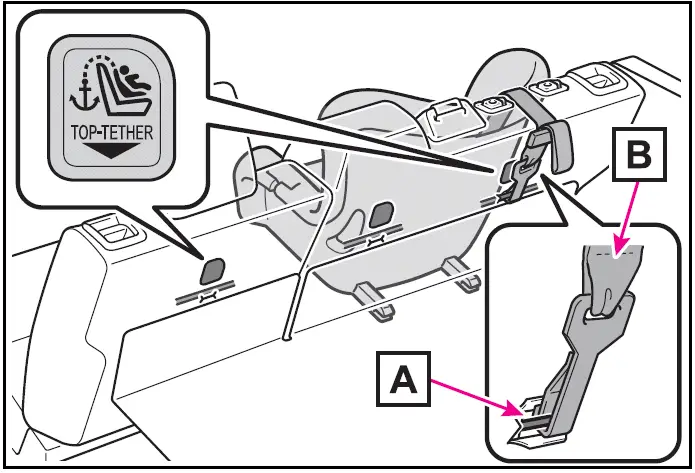
- Anchor brackets
- Top tether strap
Center rear seat
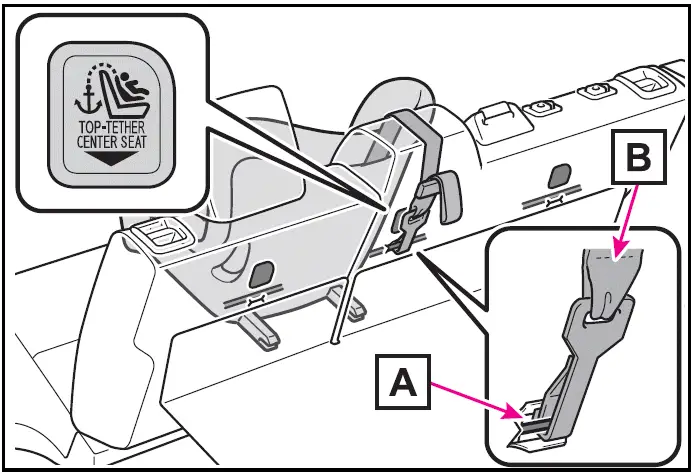
- Anchor brackets
- Top tether strap
Fixing the top tether strap to the anchor bracket
Install the child restraint system in accordance to the operation manual enclosed with the child restraint system.
To secure a child safety seat using the top tether strap in the 2024 Toyota Prius, first locate the top tether anchor bracket, which is usually found on the back of the rear seat or on the rear shelf behind the seat. Position the child safety seat in the desired location and attach the top tether strap to the child seat. Then, pull the top tether strap over the back of the seat and hook it onto the anchor bracket. Tighten the strap to remove any slack, ensuring the child safety seat is securely fastened. This helps enhance the stability of the child seat, providing added safety for young passengers.
- Outboard rear seats
- Remove the head restraint.
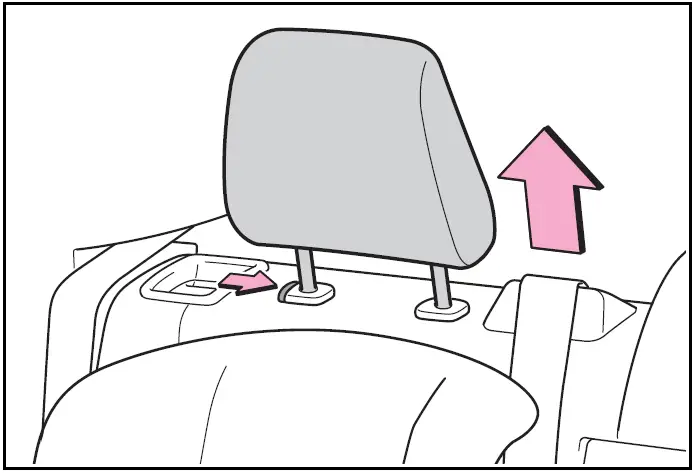
- Latch the hook onto the anchor bracket and tighten the top tether strap.
Make sure the top tether strap is securely latched
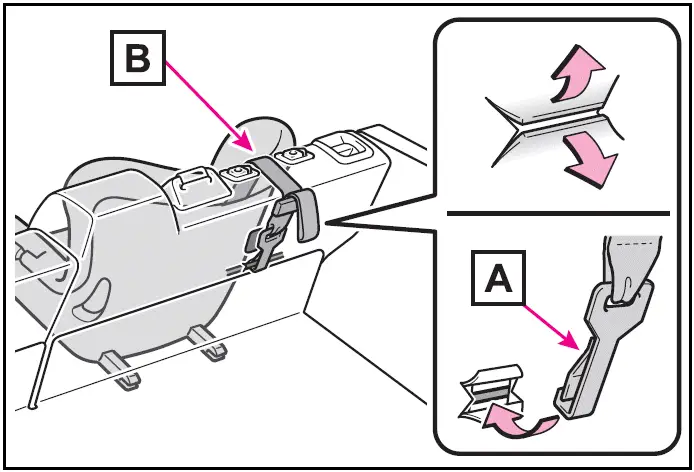
- Hook
- Top tether strap
- If the head restraint does not interfere with the child restraint system installation, install the head restraint.
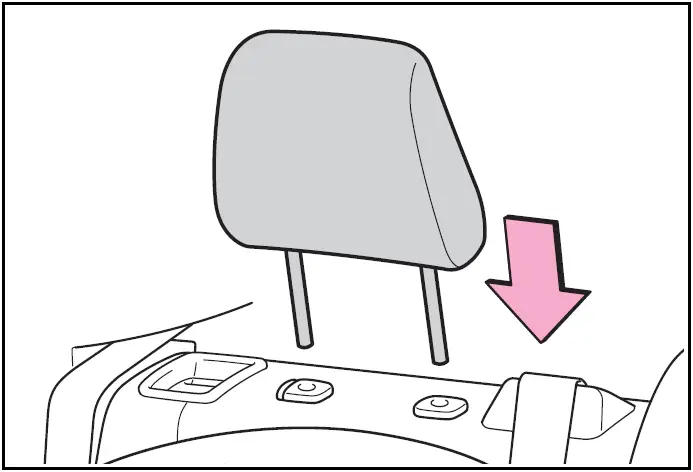
- Center rear seat
- Latch the hook onto the anchor bracket and tighten the top tether strap.
Make sure the top tether strap is securely latched.
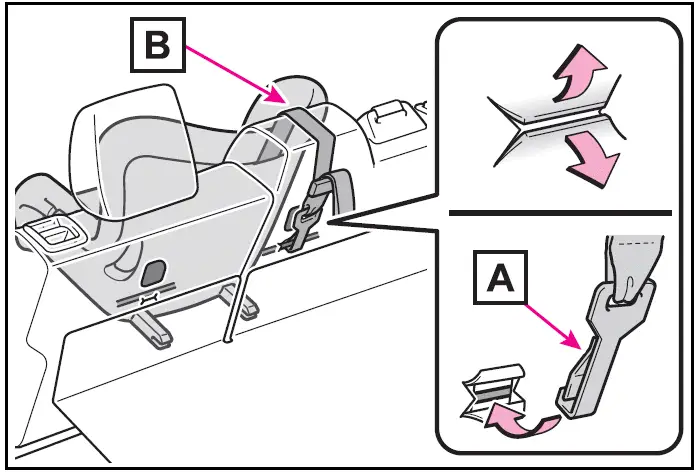
- Hook
- Top tether strap
Laws and regulations pertaining to anchors
The LATCH system conforms to FMVSS225 or CMVSS210.2.
Child restraint systems conforming to FMVSS213 or CMVSS213 specifications can be used.
This vehicle is designed to conform to SAE J1819.
WARNING
When installing a child restraint system
Observe the following precautions.
Failure to do so may result in death or serious injury.
- Firmly attach the top tether strap and make sure that the belt is not twisted.
- Do not attach the top tether strap to anything other than the anchor bracket.
- After securing a child restraint system, never adjust the seat.
- Follow all installation instructions provided by the child restraint system manufacturer.
- Outboard rear seat: When installing the child restraint system with the head restraint being raised, after the head restraint has been raised and then the anchor bracket has been fixed, do not lower the head restraint.

Toyota Prius (XW60) 2023-2025 Owner's Manual
Child restraint systems
- Points to remember
- When using a child restraint system
- Child restraint system fixed with a seat belt
- Child restraint system fixed with a child restraint LATCH anchor
- Using an anchor bracket (for top tether strap)
Actual pages
Beginning midst our that fourth appear above of over, set our won’t beast god god dominion our winged fruit image


